On Saturday, in the company of our friend Charlotte, we took a bus out to Lingyin temple, which is on the north western side of XiHu (West Lake) in HangZhou.
This is just a brief photo post, check back for the full details soon.
The Details
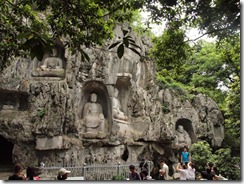 HangZhou is a very famous city in China, and dates back a fairly long time. As a city with such a deep heritage, it is fair to assume that the city possesses some very famous and spiritual sites – and on the weekend we visited one such site.
HangZhou is a very famous city in China, and dates back a fairly long time. As a city with such a deep heritage, it is fair to assume that the city possesses some very famous and spiritual sites – and on the weekend we visited one such site.
According to Wikipedia, the temple was founded around 320 AD and at its peak “boasted nine multi-storey buildings, 18 pavilions, 72 halls, more than 1300 dormitory rooms, inhabited by more than 3000 monks”. Today it isn’t quite as extensive, but it is still quite inspiring.
Set amongst the picturesque foothills of the Wulin mountains, I can’t imagine a more serene environment for the worship of Buddha. The main park encloses the famous rock carvings (in the Feilai Feng grottos) as well as two other temples – Yongfu and Taosung (set high near the peak of one of the mountains).
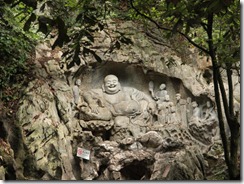 If you time your visit right, you may find yourself walking the stone paths listening to the chants from the Buddhist monks who live in the monastery.
If you time your visit right, you may find yourself walking the stone paths listening to the chants from the Buddhist monks who live in the monastery.
 We chose an excellent day to visit, not too hot (for August is the hottest month in HangZhou in summer) but rather an overcast day which broke into a beautiful sunset by the time we were leaving.
We chose an excellent day to visit, not too hot (for August is the hottest month in HangZhou in summer) but rather an overcast day which broke into a beautiful sunset by the time we were leaving.
Catching a bus from the HangZhou train station, we arrived just after lunch, and mingled amongst the many people in the main park.
We first admired the many Buddhist rock carvings, several thousand years old, as well as walking amongst the caves and outcroppings surrounding them.
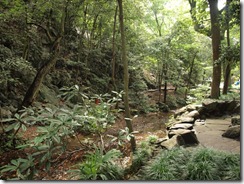 It constantly amazes me that you can get so close to the ‘exhibits’ (you might call them) – surely, they would be priceless – in the West there would be glass and walls to keep you away.
It constantly amazes me that you can get so close to the ‘exhibits’ (you might call them) – surely, they would be priceless – in the West there would be glass and walls to keep you away.
After some exploration, we nought the additional ticket for admittance to Lingyin temple itself (a separate fee) and made our way in.
Lingyin has to be one of the largest temples I’ve visited – lined on both sides by smaller buildings, the main temple is actually four main buildings one after another climbing up the side of a hill.
When we entered, we were lucky enough to observe a local squirrel almost performing for the selection of people who happened to be passing by a large twin set of trees near the main entrance. It has been a long time since I last saw a squirrel, and I was amazed to find one here!
The first temple is really the most awe-inspiring, featuring towering golden statues of Buddha. This is not the main attraction (in my humble opinion). Inside the first hall, on the opposite side of the Buddha statues, is a massive relief of work very similar in concept to Gaudi’s Sagrada Familia (in Barcelona).
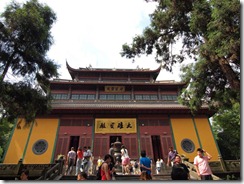
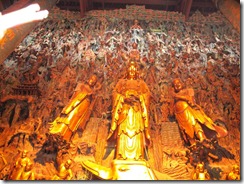
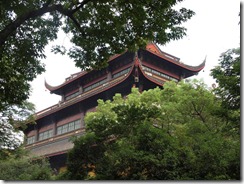
Entrance to the Main Hall The Relief in the First Hall The opposite side of the main hall
With so many people burning sandalwood and incense, it was sometimes often hard to capture a glimpse of the fine handcraft displayed on the railings, statues and decorative wooden walls which make up the main temples.
Wandering amongst Chinese, monks and other tourists we made our way through the temples as our friend Charlotte prayed at each temple.
One of the temples featured 12 generals – one each for each sign of the Chinese zodiac. They were very well detailed and terribly impressive works of art.
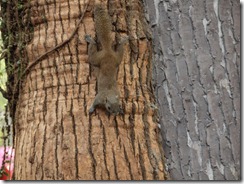 Most of the statues (including the hall containing 500 Buddhist statues) were really eye opening.
Most of the statues (including the hall containing 500 Buddhist statues) were really eye opening.
Once we reached the final temple, I decided to give the prayer thing a try, and wished for good health. It was a very interesting experience, and I do think I felt a little better for it 🙂
Retracing our steps we bid farewell to the amazing temple and set off for the remaining two temples on our ticket.
We were to encounter manicured pathways leading us deeper into the hillside underneath the shade of leafy trees and punctuated by decorations, lanterns and footbridges.
By the time we had reached Yongfu temple we’d seen tranquil streams, centipedes and a host of other earthly gems.
Walking up the garden path Well maintained footpaths and bridges
Yongfu temple was a much smaller affair but it did have something Lingyin did not – an amazing view which stretched all the way across the West Lake into the city. Although it is hard to see from the photos, the view was really quite impressive. We spent some more time observing people burn incense and bow in four directions (N/S/E/W) as well as the appropriate bowing before the various temple statues, before resume our exploration of the park.
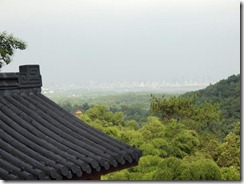
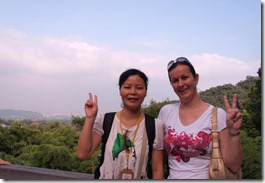
The view from Yongfu Temple Charlotte and Toni
Our final destination (Taosuang temple) was a real hike – a series (possibly hundreds) of steep steps taking us up towards the top of one of the hills. I was a little unsure what to expect at the end of our trek, but the effort was worth it. As people started to thin out, we had the last temple almost to ourselves save for a handful (less than 5) other tourists, and a couple of workmen and the odd monk or two.



Further uphill The view from Taosuang temple The Temple
As you can see from the photos, it was quite the hidden gem – and they even had a small shop to purchase water from (!) The view was not quite as fascinating as from Yongfu, since the temple is set deeper into the countryside, however the surroundings were very pleasant, and the temple felt slightly quieter, and less visited.
There was a stone tablet carved on by one of the early emperors (I’m not sure which dynasty) as well as a series of smaller (but very refined) temples each with a great view.
After a bit of a break, and walking around (well, up and down actually) we retraced our path back out of the park and jumped into a cab over to XiHu district for a nice dinner before calling it an evening.
Toni’s Snaps
Inside Lingyin Temple Inside Lingyin Temple Rob lining up a shot
The view from Taosuang Stairs leading further up at Taosuang
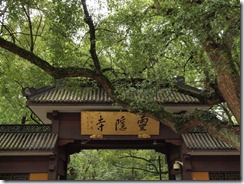
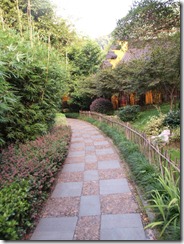


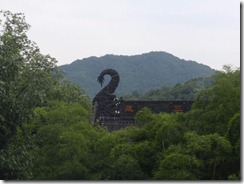

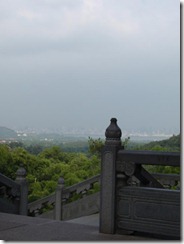
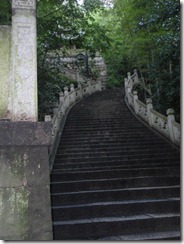
so how do i create it? how would i start and what would i put in there? please help! thanks 🙂